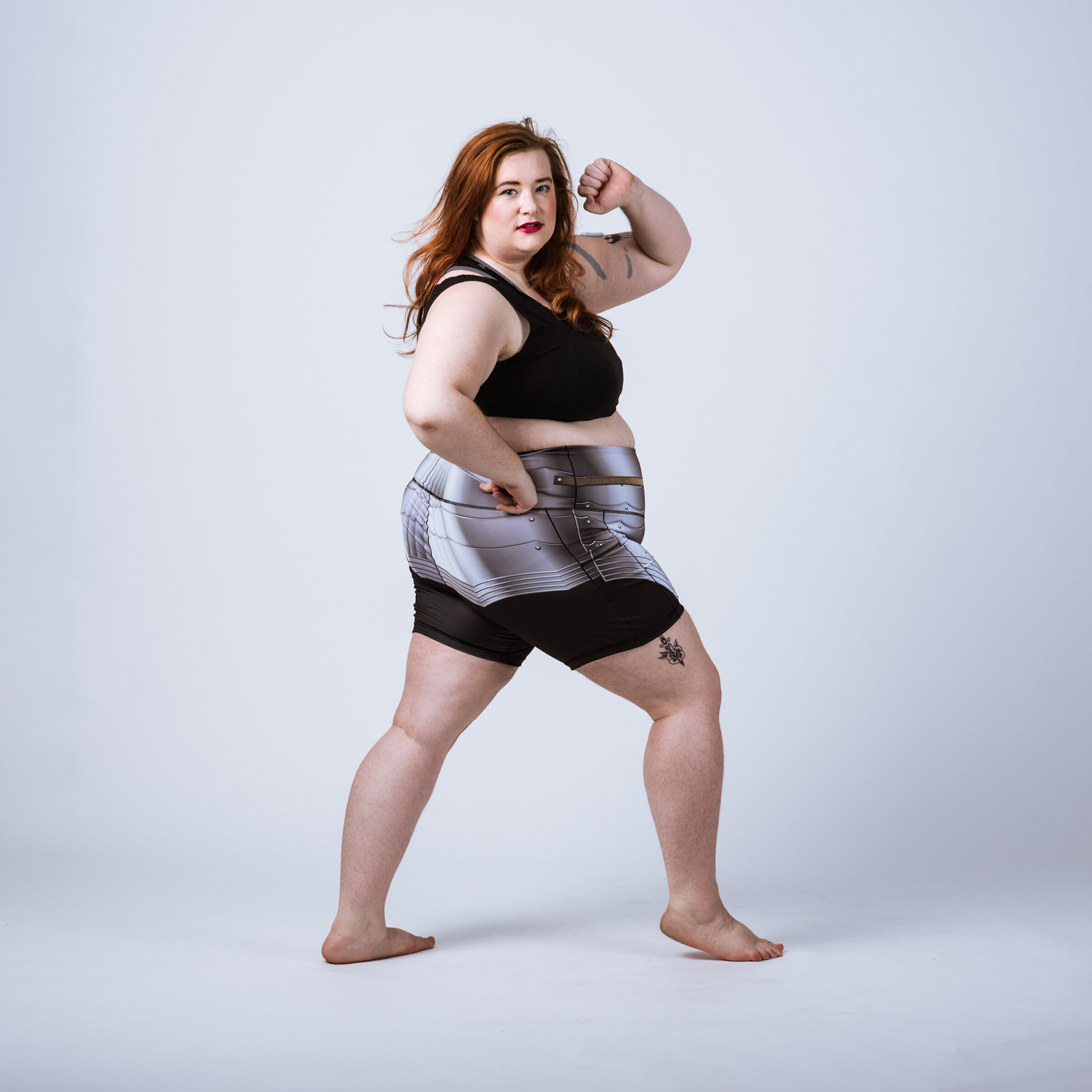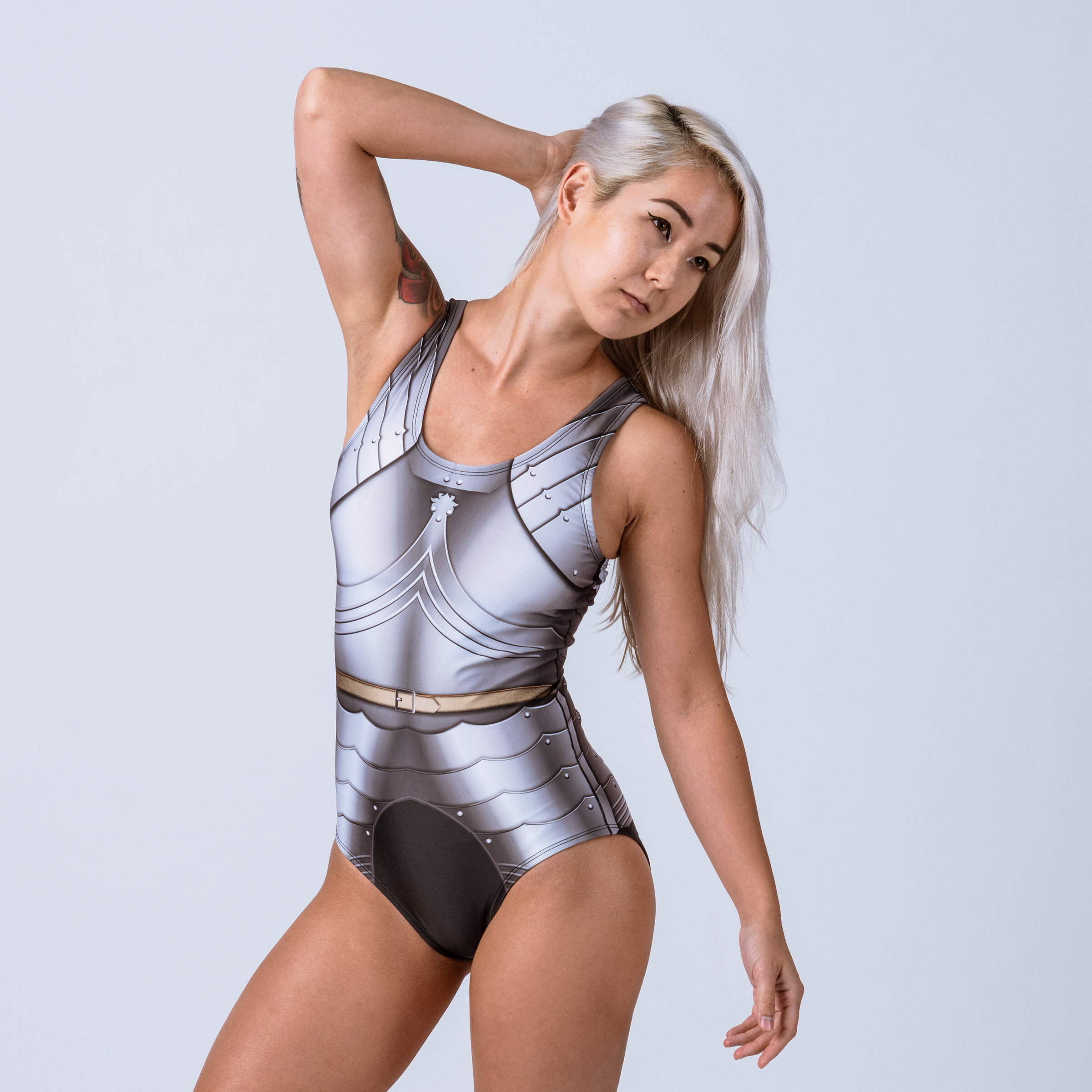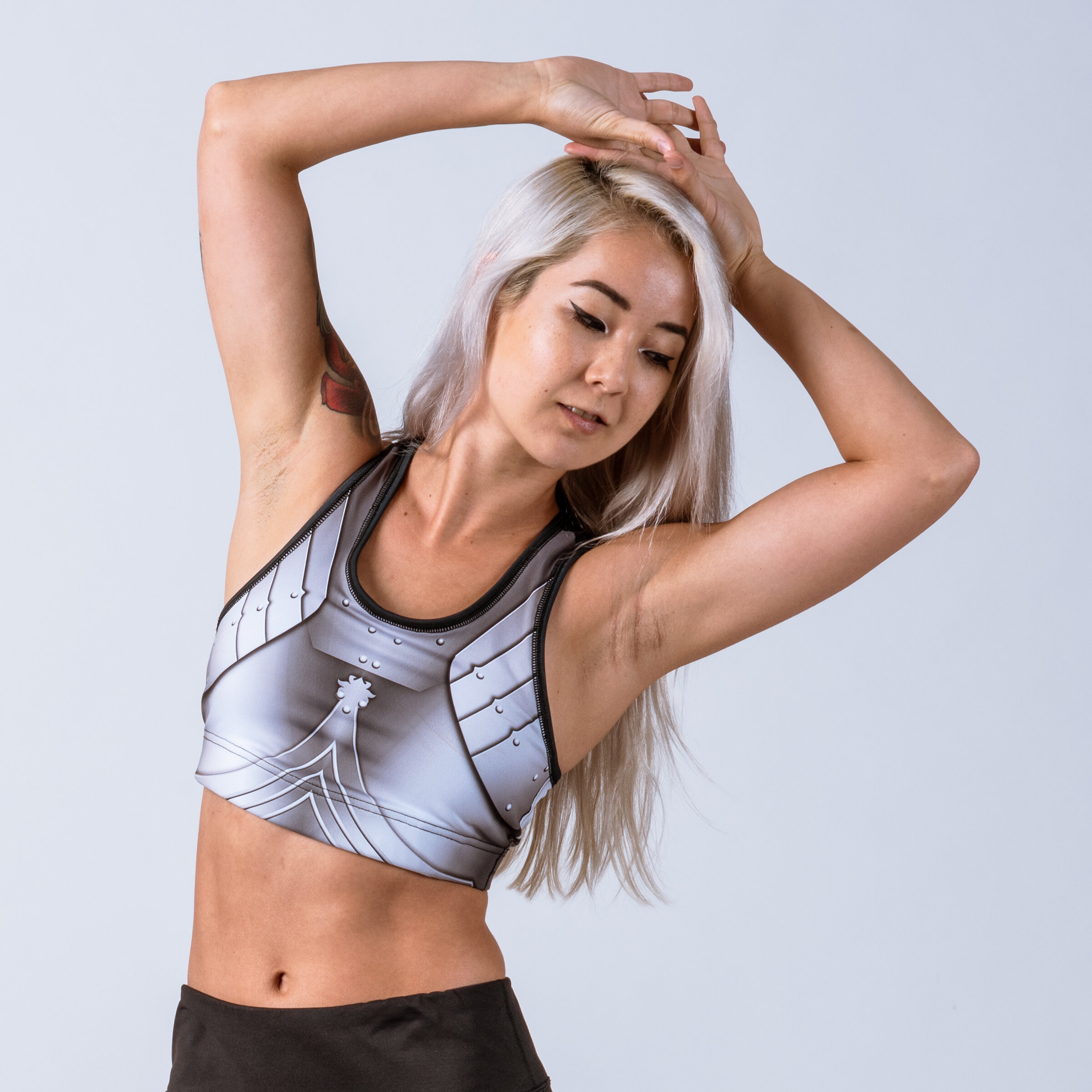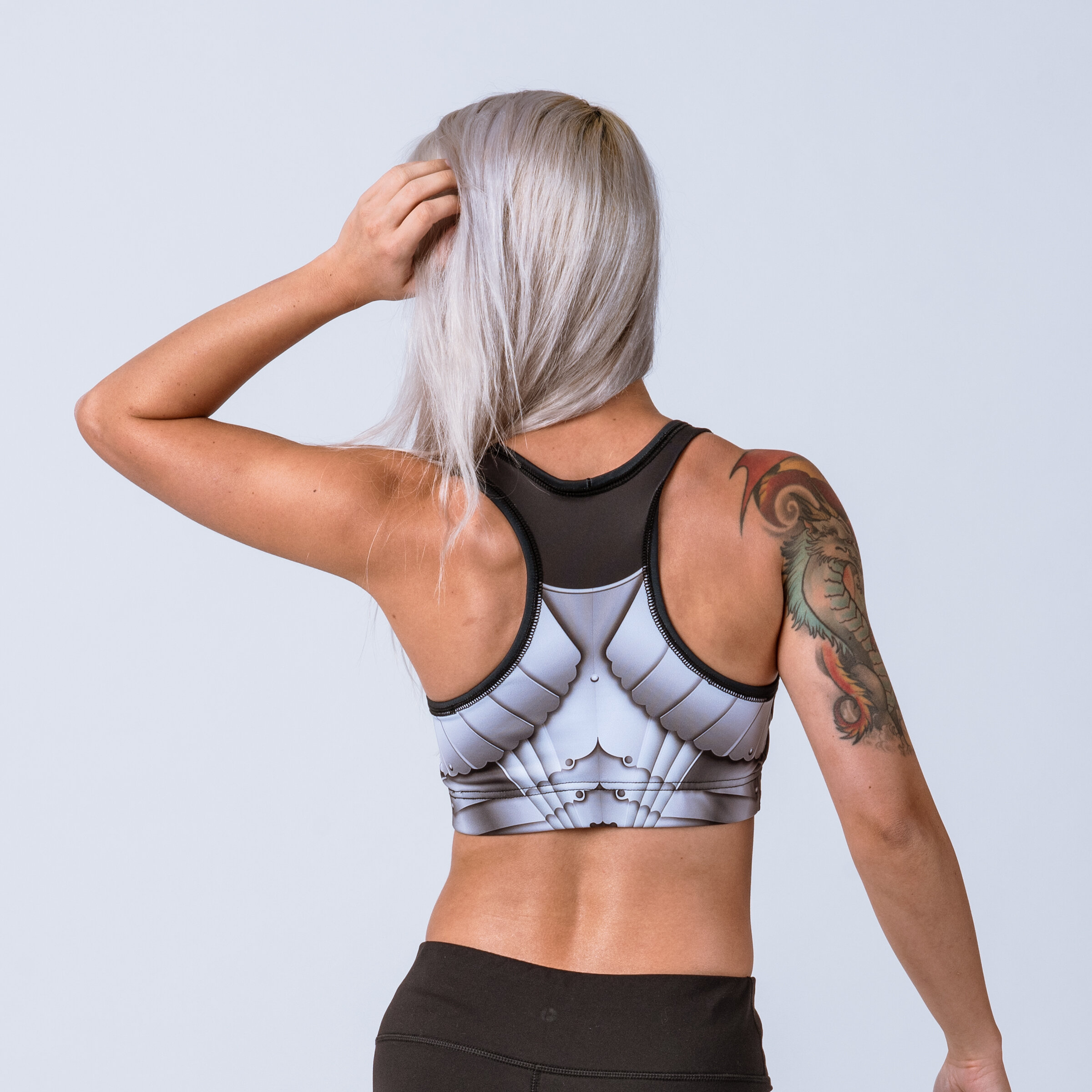Channel your inner knight with Lorica Clothing’s armor fashion
Photo credit: Lorica Clothing
There’s a well-known quote from fashion photographer Bill Cunningham that states “fashion is the armor to survive everyday life.” Here at GeekFold we couldn’t agree more. Sometimes, we can’t help but wish we could a little more literally bring armor into our wardrobe though. While wearing actual armor might be cool in theory, it’s not quite feasible for our day-to-day activities. Luckily, that’s where Lorica Clothing comes in.
Lorica brings the look of real armor to leggings, dresses, hoodies, swimsuits, and other apparel and accessories. The designs are inspired by historical pieces like infantry armor and Sir James Scudamore’s field armor. With these designs, you can find the perfect armor look to wear anywhere.
The company’s newest release is a five piece Augsburg collection inspired by German Gothic 15th century plate armor, specifically the A21 armor in The Wallace Collection. Lorica founder Elie Hutchinson told us in an email interview more about the line and why she wanted to create a company to bring armor-inspired gear to our closets!
Why did you want to launch Lorica Clothing?
I started the project that would become Lorica the summer after I graduated college in 2014, when I was looking for my first “real person job” and needed to burn creative energy in the meantime. I’ve long been a medieval history and fiction nerd, so images of gleaming steel and flashing swords have always appealed to me. I’m that girl watching Lord of the Rings, or walking through the arms and armor gallery of a museum thinking, “Heck, I would wear that!” So I thought, why shouldn’t I? Real full plate is a bit impractical for daily wear, but I’d seen enough creatively printed leggings at that point to think I can get somewhere close to the look without the price tag (not to mention weight) of a real harness.
What made you decide to turn to Kickstarter at the beginning and what was that experience like?
So the fall of that same post-grad year, I started working at an ad agency full-time. The hours were long and the work was challenging, but for the most part I enjoyed it. However, I really had to put Lorica down at first. I would do a little research now and then, here and there, but I only started taking it seriously again in 2016. I think many commercial artists can relate that when you churn out client work 24/7, you start to miss making work for yourself. I picked up Lorica again because I could feel my “spark” waning, and I needed a personal project to remind me why I loved art and design.
I had been saving money from my day job to fund this project, so I was able to afford the pattern-making and sampling stages of a clothing line all by myself. However, I knew that my squirrel fund wouldn’t be able to cover the cost of a full production run. I had heard of Kickstarter through friends who had backed several video and board games through it and I had seen other clothing brands make it, so I thought it would be the best way to see if my project had legs. Worst case, it would fail, and I would shrug and move on—I was fully prepared for the world to say, “sorry, we’re not that interested” and to accept that outcome as risk-free market research. Best case, maybe it would work out and I’d sell a hundred leggings, wouldn’t that be cool?
I was absolutely floored by how the campaign took off. Once one blog took up the story, suddenly it was on another and another, and my friends were sending me links like “ELIE LOOK AT THIS!!” I’d be sitting at work trying to focus on designing logos or whatever, but alt-tabbing to check on the figures every half hour. It was amazing.
After the campaign concluded, we ran into the “champagne problem” of not having enough capacity to fulfill the thousands of pairs by our estimated timeline, so we had to batch production and fulfill orders as chronologically as we could. We’d get a box a week with maybe 80 pairs in it at a time, I’d drive to my parents’ house after work (my little apartment definitely didn’t have enough room for a fulfillment operation) to print shipping labels and pack leggings, and then my mom would take the packages to the post office the next morning. Meanwhile my best customer service hat was on at all times to apologize to every person who wanted to know where their order was months after it was promised. It was definitely the most stressful part of the campaign. Packing the last Kickstarter package was the sweetest relief ever.
Photo credit: Lorica Clothing
Have you always had an interest in medieval armor and weaponry?
Oh, always! I grew up with stories of heroes and magic—my dad would read me kid’s versions of The Odyssey or various Arthurian legends, and my brother paged through his D&D monster manuals with me—so these images of knights on horseback, couching their lances or brandishing their swords, have been a part of my imagination as long as I can remember. As I’ve grown up, I still love fantasy and fiction, but their historical inspirations have become just as fascinating to me. I’m always amazed that real, extant armors are as beautiful or more so than many of the fantasy illustrations I’ve seen over the years.
When was the first time you combined fashion with this interest? Do you have a background in fashion design?
Lorica was really my first foray into fashion. I had no background in the industry before this project, though I have always loved fashion as a form of self-expression. It definitely has its own glossary of terms and set of best practices, so I had a lot to learn at first.
Why is sustainable fashion and having Lorica be eco-conscious important to you?
I think many people my age—I hate to say it, but “millennials”—have grown up with climate change on our minds. All children grow up loving animals and nature, but we were really the first generation with enough media access to—forgive my hyperbole—watch the world burn around us. Our childhood pop culture trumpeted, “be the change you wish to see in the world,” so here we all are, doing our best with reusable straws or backyard composting or whatever else we can do with the resources we have. If I was going to start a clothing company, I was going to try to do it the right way, because to not think about this issue [in] 2019 just feels irresponsible.
How do you decide what you want to create next? Where do you turn for inspiration or have you had a long list of armor you want to create items for since starting?
I confess my process is a rather unscientific, poorly planned “oooo, shiny, I’ll do that next!” But I have such a long list of shinies! There are so many beautiful harnesses out there, though most of them are Western European, as Renaissance full plate armor is my weakness. However, I do want to try adapting armors from as many cultures and periods as possible. I’ve done a 16th century Turkish design and several Japanese-inspired designs so far and hopefully there’s much more to come!





Your work replicates the details of the armor that inspires it. What is your process like for creating a new item? How do you go about replicating a design and deciding what type of apparel (dress, leggings, etc.) it might be best suited for?
I try to look for pieces that are very distinctive. For example, there may be slight differences between 15th century German Gothic harnesses, but by and large they all look very similar, so I don’t need more than one or two of that type of design. By contrast, armor really became more individualized and fancy in the 16th century as artists started applying very delicate decorative techniques, so there’s tons of variance there where I could adapt dozens of pieces all from the court of Elizabeth I alone.
When it comes to deciding what garment to choose as a canvas, I usually take a look at the harness in a formal sense to see what it would be best suited for. For example, many later armors forgo the greaves (shin protection) and sometimes even cuisses (thigh protection) as military tactics shifted with the proliferation of firearms in the 17th and 18th century. Those pieces would look great as dresses or tops, as they still have breastplates and faulds to adapt onto the upper body. Some armors are gorgeous from head to toe and can be adapted onto everything from leggings to swimwear, it depends!
Your new release features items inspired by 15th century German Gothic armor. What is it about this armor that inspired you and why did you choose these items for the design?
The new release is mostly based upon the A21 armor of the Wallace Collection in London. It’s a composite armor (which is to say, it combines pieces from several different armors, some of which were recreated long after the originals to match the rest of the harness), but I think it beautifully exemplifies the German Gothic style with its beautiful fluted metal and cut-outs. I think most people imagine German Gothic first when they think of shining armor because it really is that iconic look of white steel and sharp curves we associate with the romantic ideal of a knight.
Your brand helps fill a gap in geek fashion for those who want to wear armor in a variety of ways in their lives, whether a dress for a night out or as athleisure. When you look at geek fashion, what are some other areas you think still need to be addressed in offering options for fans? Where would you like to see improvements and in what ways do you still want your brand to fill any gaps?
I think Lorica is unique in that it serves a certain geek fanbase that is a little underserved right now—that is to say, history-lovers, Renn Fest goers, and re-enactors. Like any costume-based hobby, creating an outfit for events in this space can be super expensive (and sometimes uncomfortable), so armor leggings offer one alternative that might be more accessible than the real thing.
To be honest I think the geek fashion space is super-saturated with the more popular fandoms right now—Marvel, Harry Potter, Doctor Who, etc.—and I’d love to see more diversity in IPs or disciplines. There’s lots of clothing brands killing it in the video game space for example, but I think there’s tons of room to grow there and in the sci-fi or fantasy genre more broadly. There’s a lot of very high quality artisan fashion at the top of the market (like intricate corsetry, gowns, or chain/scale mail jewelry, for example), but not a lot of mid-tier items for folks who can’t plop $200-500 down on one item.
Can you tease any other releases or future offerings our readers should keep an eye out for?
The German Gothic capsule is our most recent release, but I’m trying to see if I can put together a Halloween-ish release for October, too! I’ve had requests for scales or darker armor designs, so let’s see if I can make that happen in time for the 31st.
You can find Lorica’s new German Gothic collection available now on their website.
Don't forget to sign up for GeekFold so you can receive the week's essential geek fashion news every Friday!


